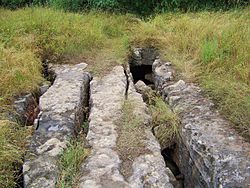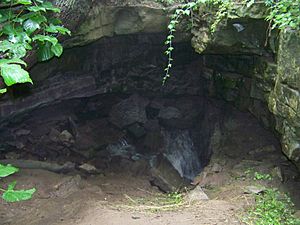Eramosa Karst facts for kids
Quick facts for kids Eramosa Karst Conservation Area |
|
|---|---|

Entrance of Nexus Cave.
|
|
| Location | Canada |
| Nearest city | Hamilton, Ontario |
| Area | 78 ha |
| Established | 2008 |
| Governing body | Hamilton Conservation Authority |
The Eramosa Karst is a special natural area in Ontario, Canada. It's located in Stoney Creek, which is part of the City of Hamilton. This unique spot is famous for its amazing geological features.
It has sixteen different karst features, which are landforms made when water dissolves rock. Seven of these are very important for the province. Experts say it's the best example of karst landforms in all of Ontario. The land here is owned by the province, the city, and even some private citizens. It was officially recognized as an important Earth Science area on February 13, 2003.
Contents
Exploring the Eramosa Karst Conservation Area
The Eramosa Karst is a protected natural space. In October 2006, the government of Ontario gave 73 hectares of land to the Hamilton Conservation Authority. This helped create a new conservation area. Then, in April 2007, another 3.1 hectares were added. The City of Hamilton also helped by adding 1.6 hectares in June 2007. This special area officially opened to the public on June 20, 2008.
Discovering Karst Landforms
The Eramosa Karst area has a unique landscape. It is crossed by the Eramosa Escarpment. This escarpment is similar to the famous Niagara Escarpment. Both are made of a rock called dolomite. However, the Eramosa Escarpment is much smaller, only about 10 metres high. Its cliffs are usually no taller than 3 metres. Most of the solid rock, called bedrock, is covered by a layer of till (sediment left by glaciers).
This area has many different types of karst features. Let's explore some of them!
What are Soil Pipes?
Soil pipes are small, tube-shaped holes in the ground. They can be a few millimetres to a few centimetres wide. These pipes act like natural drains. They carry water from the surface down into the bedrock below.
Understanding Dolines (Sinkholes)
Dolines are also known as sinkholes. In the Eramosa Karst, most dolines are "suffusion" dolines. These are dips or hollows in the ground. They form above caves or smaller spaces in loose soil. Many dolines here are created by a mix of soil pipes and water wearing away the soil. This soil was left behind by glaciers and sits on top of the bedrock.
How Karst Windows Form
Karst windows are special openings. They form when the rock roof of a cave collapses. This creates a natural "window" to the cave below. The entrance to Pottruff Cave is a great example of a karst window.
Exploring Karst Valleys
Streams in the Eramosa Karst have created unique valleys. These valleys are typical of a karst landscape.
- Blind valleys form when a stream suddenly disappears underground. Since the water no longer flows on the surface, these valleys end abruptly.
- A half-blind valley is similar. But sometimes, water might flow on the surface again further downstream from where it sank.
- Dry valleys were formed a long time ago. They were once paths for streams before the water found new underground routes through sinkholes. Depending on how old they are, these valleys might or might not have surface water flow today.
Discovering Caves
The Eramosa Karst has five caves big enough for people to enter. These are called "dissolutional" caves because they formed from water dissolving rock. Nexus Cave is the largest of these. It is 335 metres long, making it the 10th longest cave in all of Ontario!
Protecting the Eramosa Karst
The Eramosa Karst is a very important natural area. Its special status helps protect it. The main part of the conservation area matches the most important parts of the natural area. However, the "Feeder Area" is where the streams that supply the karst begin. This area is managed by a different group. There have been discussions about selling this land for building houses.
Local scientists and leaders want the government to protect these lands. They believe that if houses are built, the amazing geology and diverse wildlife of Eramosa Karst will be harmed. Protecting this area is important for everyone.
There are plans to connect the conservation area to other natural spots. These include Felker's Falls, Mount Albion Conservation Area, and the Bruce Trail. This will create a 10-kilometre path called the East Mountain Loop Trail. There's also an idea to link it to Olmstead Cave, which is in a Hamilton park.


